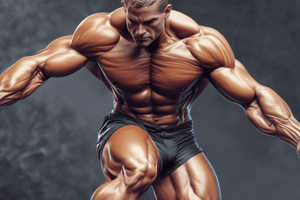Podcast
Questions and Answers
What is the relationship between muscle cross-sectional area (CSA) and strength?
What is the relationship between muscle cross-sectional area (CSA) and strength?
- Larger CSA results in less strength, as more sarcomeres reduces the overall efficiency of the muscle.
- Larger CSA results in greater strength, because more sarcomeres can be stacked in parallel or on top of each other. (correct)
- CSA has no impact on strength, as strength is determined by the muscle's volume.
- Larger CSA results in less strength, due to a decrease in the number of sarcomeres.
What is the definition of power in the context of exercise physiology?
What is the definition of power in the context of exercise physiology?
- The capacity to exert force at a given speed.
- The rate at which work is performed. (correct)
- The amount of force required to move a specific mass over a specific distance.
- The force exerted over a given distance.
Which of the following is NOT a biomechanical factor that influences human strength?
Which of the following is NOT a biomechanical factor that influences human strength?
- Muscle length
- Arrangement of muscle fibers
- Joint angle
- Body temperature (correct)
What type of muscle fiber arrangement is described as a feather-like arrangement with fibers aligning obliquely with the tendon?
What type of muscle fiber arrangement is described as a feather-like arrangement with fibers aligning obliquely with the tendon?
Which plane of motion divides the body into front and back sections?
Which plane of motion divides the body into front and back sections?
In which of these training programs would the principle of specificity be the most important?
In which of these training programs would the principle of specificity be the most important?
When is negative work performed in relation to muscle contraction?
When is negative work performed in relation to muscle contraction?
Which of these factors represents the rate at which repetitions are performed, determining the power output?
Which of these factors represents the rate at which repetitions are performed, determining the power output?
Flashcards
Anatomical Planes
Anatomical Planes
The three main sections of the body: sagittal, frontal, and transverse.
Sagittal Plane
Sagittal Plane
Divides the body into left and right sections.
Frontal Plane
Frontal Plane
Divides the body into front (anterior) and back (posterior) sections.
Transverse Plane
Transverse Plane
Signup and view all the flashcards
Specificity in Exercise
Specificity in Exercise
Signup and view all the flashcards
Muscle Cross-Sectional Area (CSA)
Muscle Cross-Sectional Area (CSA)
Signup and view all the flashcards
Negative Work
Negative Work
Signup and view all the flashcards
Pennate Muscle
Pennate Muscle
Signup and view all the flashcards
Study Notes
Biomechanics of Sport Applications
- Force equals mass times acceleration (F=ma)
- This principle is fundamental to understanding forces in sport
- Ground Reaction Force (GRF) of 2004N is a force exerted by the ground on the body during movement
- Force vectors include horizontal and vertical components (e.g. Fy, Fx)
- Angle of 122 degrees may represent a force orientation
- 49 degrees is also a possible angle measure in a force diagram
Anatomical Planes
- Body is erect, arms down, palms forward by definition in human biomechanics
- Sagittal plane divides the body into left and right sections
- Frontal plane slices the body into front and back sections
- Transverse plane divides the body into superior (upper) and inferior (lower) sections
Key Point: Specificity
- Specificity of exercise is crucial
- Analyze the sport movements; qualitative or quantitative
- Identify joint movements to understand whole-body actions
- Exercise programs should emphasize and target similar joint movements
Joint Movements in Sport
- Numerous diagrams of specific joint movements in different sports. This data allows for exercises that target specific actions.
- Examples include: wrist flexion/extension, elbow flexion/extension, shoulder flexion/extension, lower back flexion/extension, hip flexion/extension, and more.
Biomechanics of Strength
- Factors influencing strength include:
- Arrangement of muscle fibers
- Muscle length
- Joint angle
- Muscle contraction velocity
- Joint angular velocity
- Strength-to-mass ratio
- Body size
Human Strength and Power
- Basic Definition
- Strength: Capacity to exert force at speed
- Work: Force * Distance or Torque * Angular Displacement
- Power: Force * Velocity or Work / Time
- Negative work occurs when a muscle is put under force.
Muscle Cross-Sectional Area (CSA)
- Muscle force is related to cross-sectional area, not volume
- Greater CSA means more sarcomeres in parallel
- Equal CSA means equal strength, but smaller volume (such as in gymnasts) means more power
Pennation
- Muscle fiber arrangement varies
- Pennate muscles have obliquely aligned fibers with a tendon
- Angle of pennation is the angle between muscle fibers and line from origin to insertion; 0 degrees means no pennation
Muscle Fiber Arrangements
- Muscles with greater pennation have more parallel sarcomeres and fewer sarcomeres in series
- This results in greater force generation but lower shortening velocity.
- Pennation can be disadvantageous for eccentric and isometric muscle actions.
References
- Haff & Triplett. Essentials of Strength Training & Conditioning, 4th edition
- Kenney, Wilmore, Costill. Physiology of Sport & Exercise, 6th edition
- McCardle, Katch, Katch. Exercise Physiology: Nutrition, Energy, and Human Performance, 8th edition.
Studying That Suits You
Use AI to generate personalized quizzes and flashcards to suit your learning preferences.




